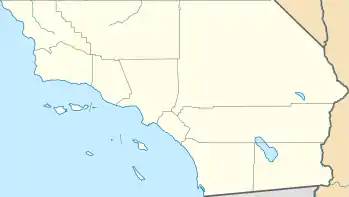Sespe Condor Sanctuary
The Sespe Condor Sanctuary is a 53,000-acre (210 km2) wildlife refuge in the Topatopa Mountains, in northeastern Ventura County, California. It is within the Sespe Wilderness in the southern Los Padres National Forest.
| Sespe Condor Sanctuary | |
|---|---|
IUCN category Ib (wilderness area)[1] | |
.jpg.webp) The Topatopa Mountains within the Sespe Condor Sanctuary | |
 Sespe Condor Sanctuary Location in Southern California | |
| Location | Ventura County, California, United States |
| Nearest city | Fillmore, California |
| Coordinates | 34.492137°N 118.939790°W |
| Area | 53,000-acre (210 km2) |
| Elevation | 3,182 feet (970 m) |
| Designation | Condor Sanctuary |
| Created | 1947 |
| Administrator | United States Forest Service |
| Website | Sespe Condor Sanctuary |
History
The United States Forest Service established the Sespe Condor Sanctuary in 1947 for the California condor, an endangered species which is the largest living bird in North America.[2][3]
On January 14, 1992, two captive-bred California condors and two Andean condors were released into the Sespe Condor Sanctuary, overlooking the Sespe Creek, near Fillmore, California. This was done by the U.S. Fish and Wildlife Service's Hopper Mountain National Wildlife Refuge Complex, the lead office for the California Condor Recovery Program. These captive-bred condors thrived in the wild and have begun to reproduce freely.[4]
Before the sanctuary was established, numerous condors were killed by power line collisions. In order to circumvent this mishap, the captive condors were treated with "mock power poles" through the power pole aversion program. These poles emitted mild shocks when landed upon. They quickly learned to avoid power poles, which has significantly reduced their mortality rate.
Future plans
Currently the California Condor Recovery Program is in effect in California, Arizona, and Baja. There are nearly 450 California condors in the world, with more than 275 flying free in the wild.[5] California has four release sites, of which the Sespe Condor Sanctuary is one. With the advent of more natural condor births, more release sites are in the works.[6]
See also
- Sespe Creek
- Fishes of Sespe Creek, California
- National Wildlife Refuges in California
- Topatopa Mountains
References
- "Protected Planet | Sespe". Protected Planet. Retrieved 2020-10-16.
- "Basic Facts About California Condors". Defenders of Wildlife. 18 March 2012. Retrieved 11 December 2017.
- "California Condor". Los Padres Forest Watch. 24 April 2012. Retrieved 11 December 2017.
- "California Condor". U.S. Fish & Wildlife ServiceHopper Mountain National Wildlife Refuge. Archived from the original on 3 July 2007. Retrieved 11 December 2017.
- Myatt, Jon; Woodbridge, Michael. "California Condor Recovery Program". www.fws.gov. Pacific Southwest Region, U.S. Fish and Wildlife. Retrieved 11 December 2017.
- "California Condor Reintroduction & Recovery (U.S. National Park Service)". www.nps.gov. Retrieved 11 December 2017.